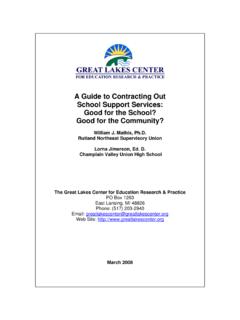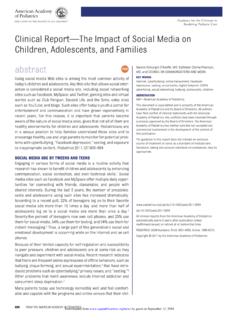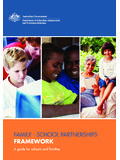Transcription of PROMOTING ELL PARENTAL INVOLVEMENT: …
1 PROMOTING ELL PARENTAL involvement : challenges IN contested TIMES. M. Beatriz Arias, Milagros Morillo-Campbell, Arizona State University The Great Lakes Center for Education Research & Practice PO Box 1263. East Lansing, MI 48826. Phone: (517) 203-2940. Email: Web Site: January 2008. PROMOTING ELL PARENTAL involvement : challenges in contested Times M. Beatriz Arias and Milagros Morillo-Campbell, Arizona State University Executive Summary This policy brief analyzes factors related to the implementation of effective PARENTAL involvement with English Language Learners (ELLs). As the largest growing segment of the student population, ELLs have increased in all states over the last twenty years. At the same time, parents of ELLs face daunting barriers as they try to become informed or involved in their child's school.
2 These barriers, which include the inability to understand English, unfamiliarity with the school system, and differences in cultural norms and cultural capital, can limit parents' communication and school participation. Research supports the importance of PARENTAL involvement for improved student achievement, better school attendance, and reduced dropout rates regardless of socioeconomic background or ethnicity. Accordingly, and given the achievement gap between ELLs and English proficient students, it is very important to identify practices that may improve ELL PARENTAL involvement and thus student achievement. Yet many programs make little effort to promote ELL PARENTAL involvement , defining PARENTAL involvement only in terms of the schools'. needs or in terms of a deficit-based perception of ELL families.
3 This brief analyzes characteristics of the ELL student and parent population; barriers to ELL family engagement with schools; and characteristics of traditional and non-traditional PARENTAL involvement models. Diversity in ELL parents and their communities speaks to the need for both traditional and non-traditional models for ELL PARENTAL involvement . With a dual-model approach, variation in language proficiency is acknowledged, communication is facilitated and maintained, and communities are recognized and integrated within the school culture. Accordingly, it is recommended that policy makers: Support the implementation of traditional PARENTAL involvement programs that are culturally relevant and linguistically appropriate. Fund the implementation of non-traditional PARENTAL involvement programs that reflect a reciprocal involvement in the school/parent community.
4 Support the professional preparation of teachers who can identify community funds of knowledge for curricular development and school outreach. 1 of 22. Support community-based education programs that inform parents about school values and expectations and work with parents to help them become advocates for their children. 2 of 22. PROMOTING ELL PARENTAL involvement : challenges in contested Times M. Beatriz Arias and Milagros Morillo-Campbell, Arizona State University Introduction This policy brief analyzes factors related to the development of effective PARENTAL involvement for English Language Learners (ELLs). The authors explain that approaches to developing PARENTAL involvement in marginalized communities, including communities with ELL students, have often been based on deficit views of ELLs and have not recognized forms of social capital that exist in those communities.
5 But these strengths can serve as a foundation for effective family and PARENTAL In the current context of anti-immigrant and English-only policies in many jurisdictions, schools are doubly challenged to serve their communities in culturally and linguistically appropriate ways. This policy brief provides both an overview of the characteristics of the ELL population generally and a closer look at the Latino population specifically. It summarizes factors that inhibit PARENTAL involvement with schools, parents' views of their role, and innovative school efforts to promote PARENTAL involvement in ELL communities. Finally, it offers recommendations for policymakers. Characteristics of the ELL Population The last twenty-five years have witnessed significant changes in the demographic profile of the student population.
6 During that time, the fastest growing segment of the school-age population has been English Language Learners (ELLs), doubling their numbers from approximately 2. million in 1989-90 to more than 5 million in 2004-05. In 2004-05, ELLs represented of the total public school student enrollment. While ELL students are identified as Limited English Proficient (LEP) students in many government reports, for purposes of this brief the term ELL will be used to refer to students whose first language is not English, encompassing both students who are just beginning to learn English and those who have already developed considerable ELL. students share one important educational variable the need to increase their proficiency in English but they differ in language, cultural background and socioeconomic status.
7 The term ELL includes students from Native American communities, long-established language minority 3 of 22. communities in the , migrant families, and immigrant groups who represent the most recent arrivals. Table 1, below, indicates the top 10 languages spoken by ELL. students by grade level in 2000. Spanish is the language spoken by most ELL students K-12. Today, more than 80% of all ELL students are native Spanish speakers. Asian languages (Chinese, Vietnamese, Korean and Hmong) are spoken by ELLs at a much lower percentage (3%), but their numbers are on the increase. While Native American languages are not represented numerically in the top ten languages, more than 116. indigenous languages were counted in the 2000 Census reports that the Navajo language had the most speakers in 2000, with over 178,000 over the age of 5.
8 Other North American indigenous languages with speakers over the age of 5 including Apache, Cherokee, Choctaw, Dakota, Keres, Pima and Yupik totaled over 203, 466 in 2000. The growth in the adult ELL population mirrors that of the K-12. population for the same years, showing an increase of 52% from 14. million to million adults during the decade between 1990 and Table 1: Top 10 Languages Spoken by Limited English Proficient Children by Grade Level, 2000. PK to 5th Grade 6th to 12th Grade Number (1,000s) Percent Number (1,000s) Percent Spanish 1,359 Spanish 1,394 Chinese 46 French 58 Vietnamese 44 Vietnamese 57 Korean 25 Chinese 53 Hmong/Miao 24 Korean 31 French 20 French/ 27 Haitian Creole German 19 German 25 Russian 17 Russian 21 French/Haitian 16 Hmong 21 Creole /Miao Arabic 14 Tagalog 20 /Filipino All languages 1,676 All 1,612 languages Source: Census of Population and Housing, 1 percent Public Use Microdata Sample, 2000 cited in Capps et al.
9 , 2005. While the growth of ELLs has been evident nationwide, the impact on individual states has been uneven. Some states have traditionally had the largest numbers of ELL students; other states are experiencing recent unprecedented growth in the ELL population primarily due to 4 of 22. Table 2 below identifies those states that have the highest ELL enrollment and those that have recently experienced significant growth. In the latter category are Nevada (354% growth) and Nebraska (350%), as well as four other states with rates over 200%: South Dakota, Georgia, Arkansas, and ,7. The notable expansion of the ELL population, both adult and student, has led some policy makers to worry that lack of English skills and knowledge of school practices may affect PARENTAL involvement with schools.
10 Furthermore, the recent anti-bilingual legislation introduced in four states and passed in three (California, Arizona and Massachusetts)8. reinforces the perception that there is hostility toward native language use by schools. The nation is experiencing the highest growth of non-English speaking students at a time when linguistic tolerance seems to be at a nadir. School policies addressing ELL PARENTAL involvement are particularly important in this time when too many students are experiencing linguistic chauvinism and anti-immigrant hostility. Table 2: States with Differential Growth in ELLs by Grade Level, 2000. PK to 5th Grade 6th to 12th Grade Number Share of Percent Number Share of all Percent of children all change of children change (1,000s) children 1990- children (percent) 1990- (percent) 2000 (1,000s) 2000.




